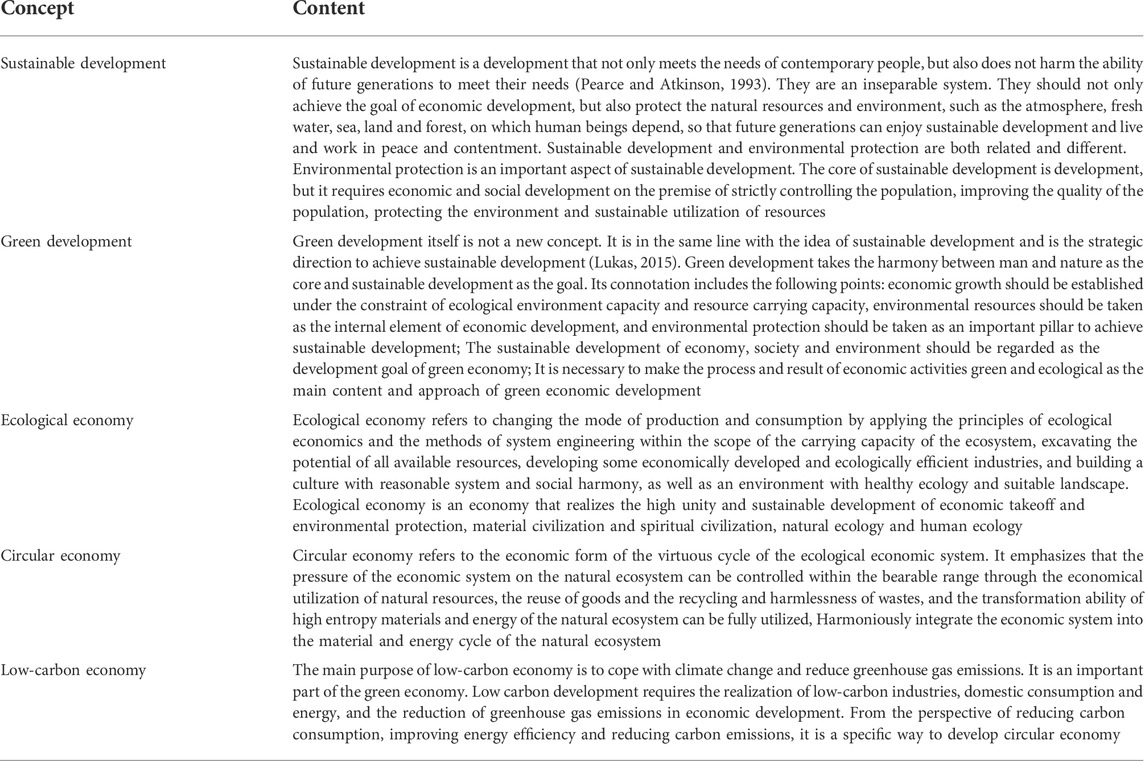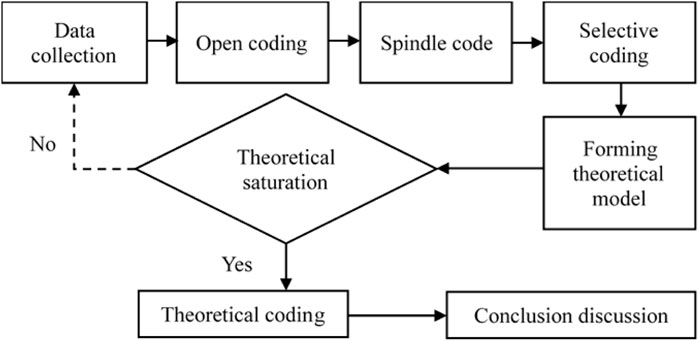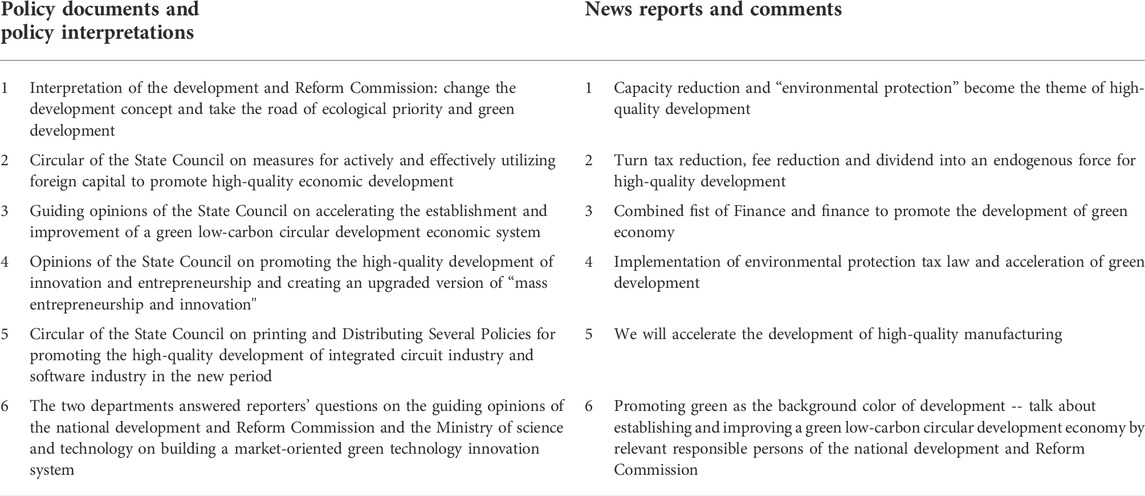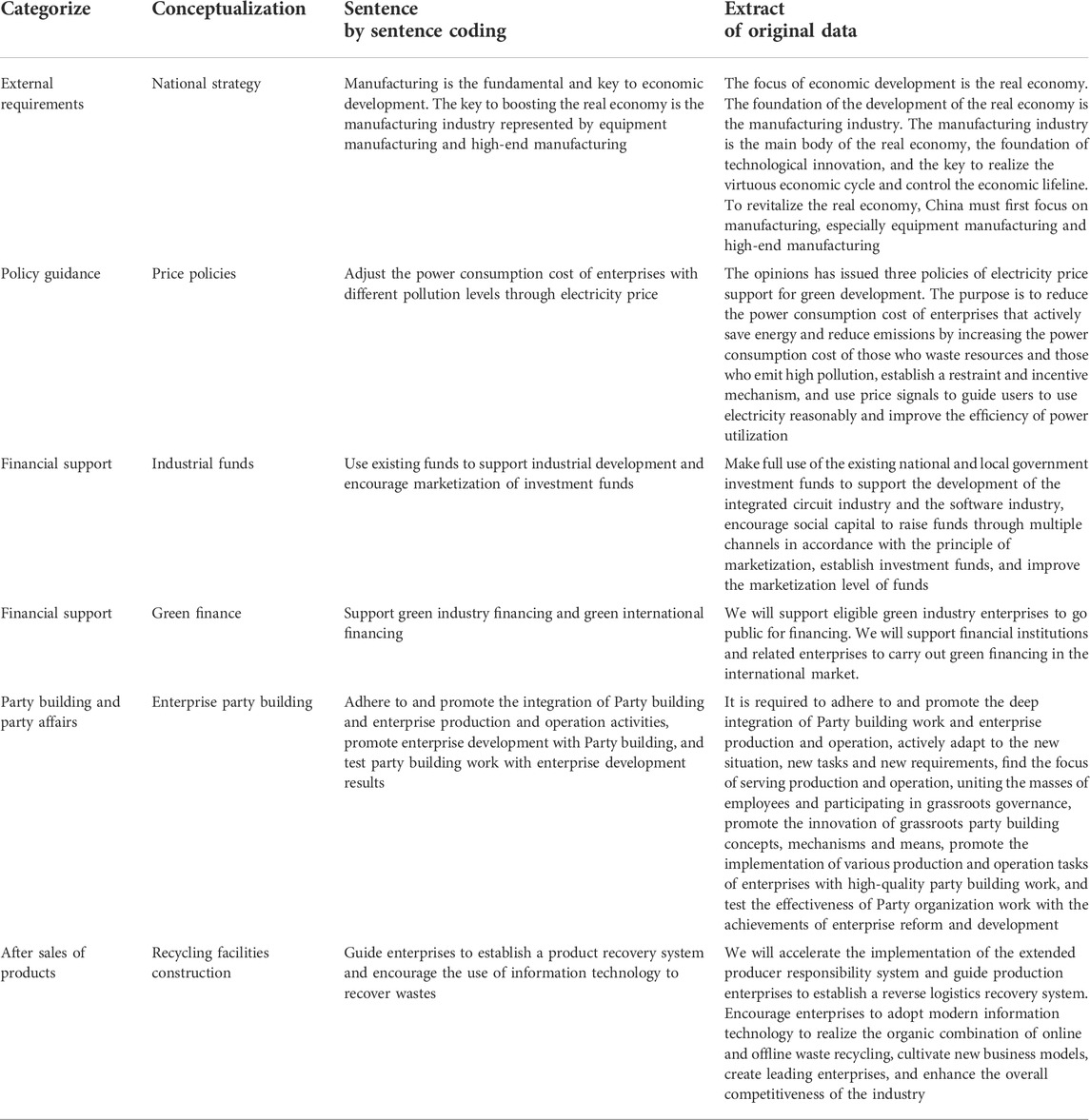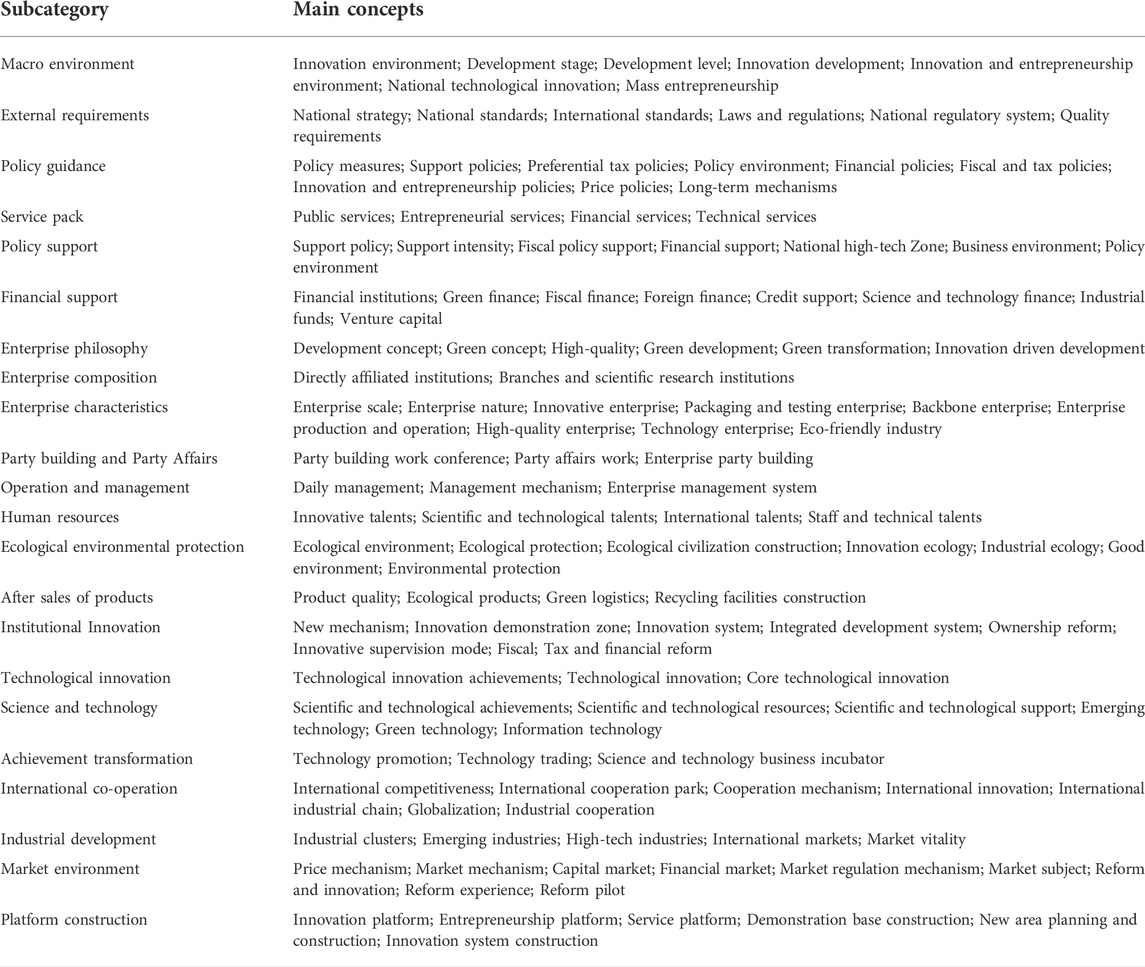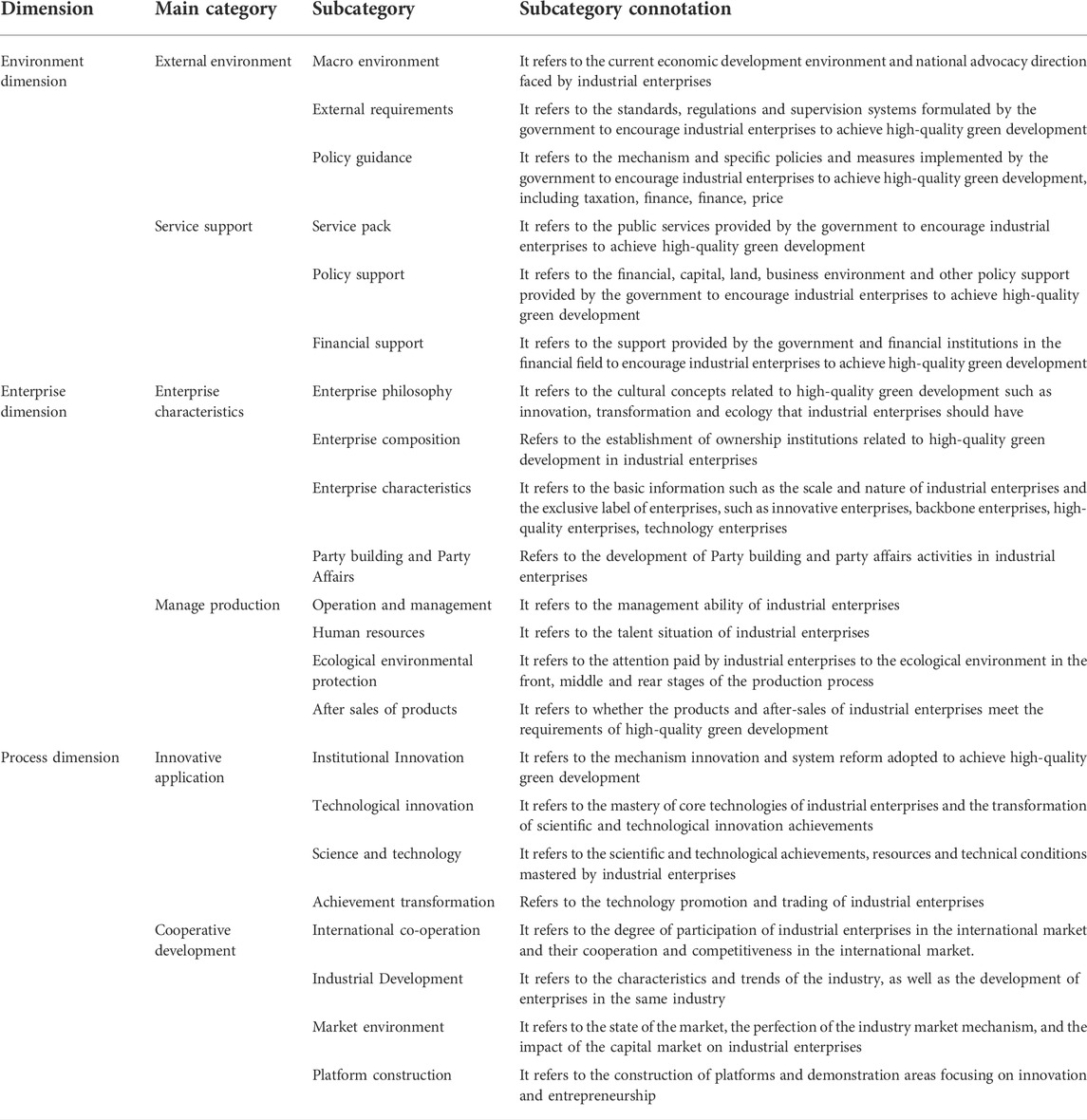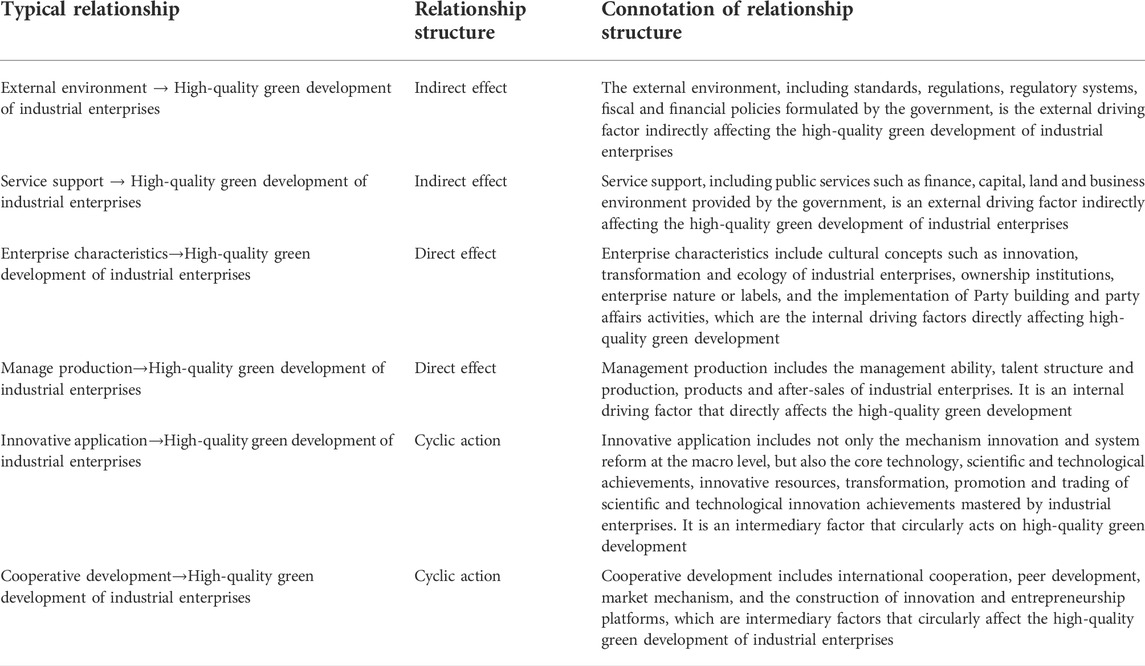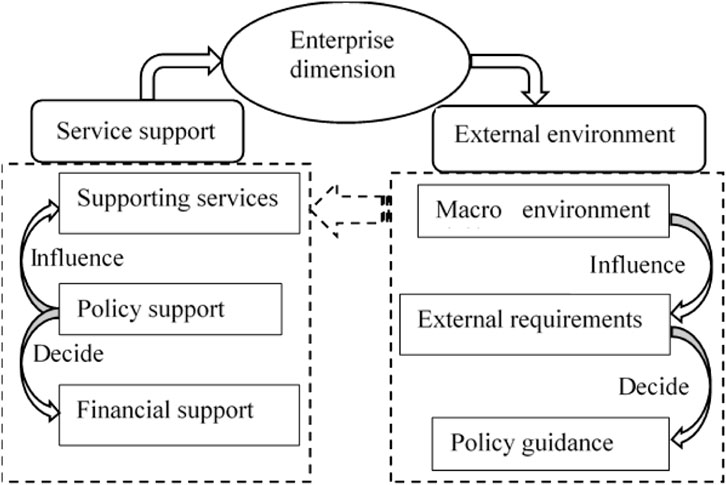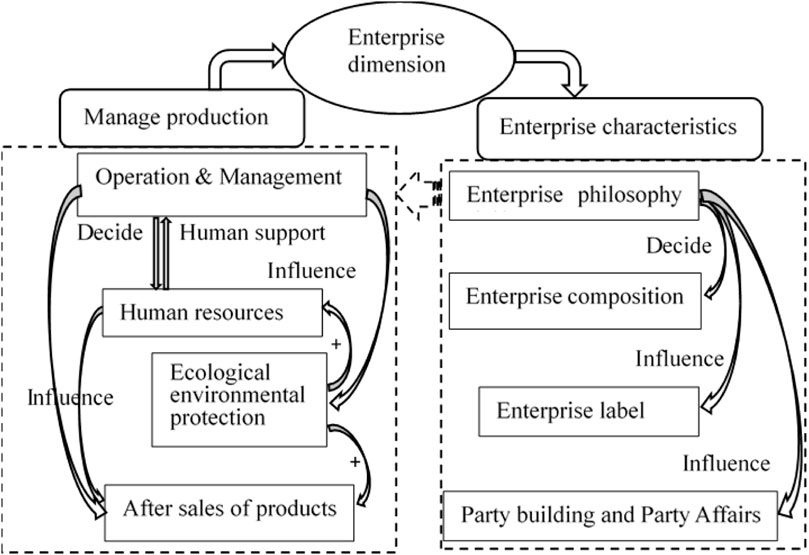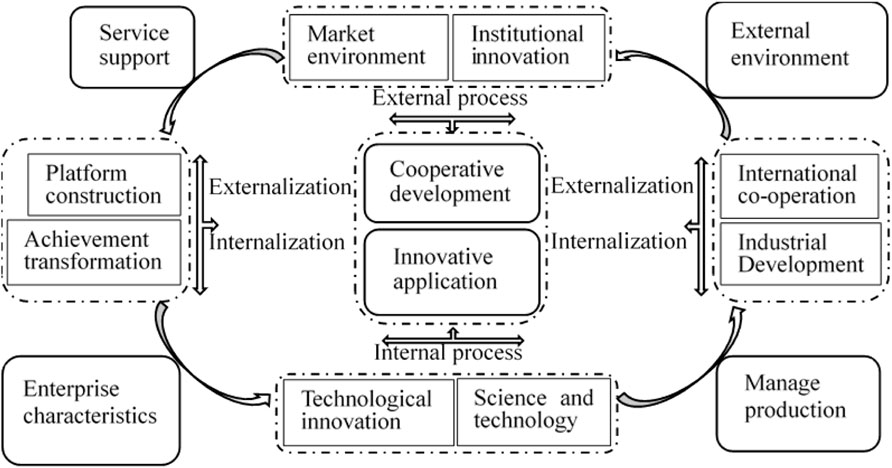- 1School of International Trade and Economics, Shandong University of Finance and Economics, Jinan, China
- 2Sinotruk Finance Co., Ltd., Jinan, China
- 3School of Management, Ocean University of China, Qingdao, China
The strategic planning and decision making of the government in the combination of high-quality development and green development has had a far-reaching impact on the development of industrial enterprises. This paper grounded theory to build a theoretical framework model of the factors that influence the development of high-quality green industrial enterprises. The data are based on policy documents, policy interpretations, official public opinion, and other original text materials related to the high-quality green development of Chinese industrial enterprises. The research finds that the factors that influence the high-quality green development of industrial enterprises can be divided into three dimensions, including the environmental dimension, the enterprise dimension, and the process dimension. Among them, the enterprise dimension is the most core dimension and directly affects the high-quality green development of industrial enterprises. Different parts (six parts) in each dimension are connected together to form a circular chain of high-quality green development of industrial enterprises. There is also an interaction mechanism within each part.
Introduction
The development of industrial enterprises plays an important role in China’s economic system (Xue et al., 2022; Shen et al., 2022). At the same time, the rapid development of industrialization also brings about a series of ecological problems such as environmental pollution (Ren et al., 2022; Zheng et al., 2020). The negative externalities caused by the extensive industrial economy have attracted great attention from the state and the people. Under the background of the development of industrial enterprises with green development as the leading concept, the 19th National Congress of the Communist Party of China put forward the relevant expression of “high-quality development” (Liu et al., 2021; Deng et al., 2021). The quality of economic growth needs to be improved and the industrial structure needs to be optimized; At the same time, the 19th CPC National Congress also proposed to establish and improve the economic system of green and low-carbon circular development, which shows that the concept of high-quality development and green development are arranged in one continuous line and are closely related (Hao et al., 2020; Xu et al., 2020). The Fifth Plenary Session of the 19th CPC Central Committee in 2020 clearly pointed out that high-quality development will be the theme of China’s economic and social development during the 14th Five-Year Plan period. During the 14th Five-Year Plan period, industrial enterprises should adhere to the new concept of green development and high-quality development, deepen supply side structural reform, strictly control product quality, improve production efficiency, and change the development mode of industrial enterprises (Ren et al., 2021).
‘Green development’ and ‘high-quality development’ have been regarded as common-sense goals by the Chinese government, and high-quality development is regarded an important means to achieve green development. The high-quality guidance theory of green development believes that the implementation of high-quality development policies can promote green development, and green is the inevitable requirement of high-quality development (Ren and Wen, 2018; Hong et al., 2020). The high-quality ecological environment and the supply of green energy are important components of high-quality development. Macroscopically, high-quality economic development can improve the efficiency of resource allocation and optimize the market structure and mechanism; At the microlevel, high-quality is reflected in the improvement of total factor productivity of enterprises. In industrial enterprises with high pollution and high consumption, the promotion effect of the productivity of the total factor is more obvious. Investing less resources (capital, means of production, land, labor) will obtain more expected outputs (products, by-products with economic value) and less unexpected outputs (pollution, waste) (Chen and Chen, 2018). In the concept of green development, there are clear requirements for social benefits, unit energy consumption, and pollutant emission after the production process (Wang et al., 2019). The green development of industrial enterprises should produce more social welfare and less pollution emissions under the condition of low unit energy consumption (Wu et al., 2020; Wang et al., 2021). The effect of high-quality development of industrial enterprises is consistent with the needs of green development. Therefore, the high-quality development of industrial enterprises can guide their green development.
Although scholars try to explore the factors of that influence the high-quality development or green development of enterprises. For example, enterprise scale and technology investment have a significant positive impact on the high-quality development or green development efficiency of enterprises (Yao et al., 2021; Dhar et al., 2022); Environmental regulation and the intensity of foreign investment have significant negative effects (Zhang et al., 2020; Hao et al., 2022). However, the above research separates high-quality development from green development and does not consider the particularity of high-quality green development of industrial enterprises. In this way, we only analyze the influence mechanism of various factors from a macro-perspective. Ignoring the practical needs and subjective initiatives of industrial companies to achieve green development.
In view of this, this paper mainly discusses the following two issues: 1) What factors will affect the high-quality green development of industrial enterprises; 2) What is the logical relationship between the factors that affect the high-quality green development of industrial enterprises? This paper combs the concept of high-quality development and green development of industrial enterprises, analyzes the internal and external elements involved in high-quality green development of industrial enterprises, and explains the logic and mechanism. In terms of research perspective, considering the subjective initiative of enterprises, we should look for factors for industrial enterprises to achieve high-quality green development from a micro-perspective. In terms of research methods, we theoretically encode relevant documents, such as policies, through grounded theoretical methods. In terms of the research results, the internal factors of the enterprises are emphasized, and the influencing factor model of high-quality green development of industrial enterprises with three dimensions of environment, enterprise and process is constructed.
Literature review
Influencing factors of high-quality development and green development
The high-quality development of industrial enterprises corresponds to the high-speed growth of industrial enterprises in the past (Jin, 2018; Wu et al., 2022). In the fields of economics and management, there have been profound and comprehensive studies on factors that lead to rapid growth of industrial enterprises. From the exploration of single factors such as R&D investment, capital investment, resource environment, and industrial structure to the research of all the factors, the rapid economic growth is the basic condition (Yang, 2015). With the increasing pressure of rapid economic growth, scholars began to think about the reasons for the hindered development of industrial enterprises. Cardinale (2021) believes that the monopoly of large state-owned enterprises in downstream industries leads to the failure of resource allocation and hinders the vitality of downstream manufacturing. Although industrial competition can release economic vitality, there is no correlation between industry scale and resource mismatch, and the failure of resource allocation has limited explanatory power in the economic downturn (Danisman et al., 2021). When the industrial economy develops to some extent and the resource carrying capacity is close to saturation, resource constraints must be considered for economic growth (Madsen and Hansen, 2019).
There are many factors influencing the green development of industrial enterprises. For example, Shapira et al. (2014) believe that strict laws can guide industrial enterprises to implement green production. Zhu et al. (2019) found that government science and technology investment under environmental regulation will positively affect the green development of industrial enterprises; Khan et al. (2022) pointed out that technological innovation can significantly increase the development level of local green economy. According to the relevance with enterprises, the above motivation research can be divided into internal factors and external factors. Internal factors are factors that industrial enterprises can change through self-awareness, including enterprise green cognition, marketing strategy, enterprise behavior, cleaner production. (Rana et al., 2020; Begum et al., 2022; Deganello and Bos, 2022). External factors are factors that cannot be changed by industrial enterprises through self-awareness, including inter enterprise cooperation, social networks, institutional pressure, green finance, circular economy concept, government and public environmental awareness. (Khan and Khan, 2019; Sikander et al., 2021; Akomea-Frimpong et al., 2022).
Relevant research on the factors influencing high-quality development or green development has begun at home and abroad, but the current level of research is not in depth. Specifically reflected in: first, the current research on the combination of high-quality and green development is less, and most of the research only focuses on a single aspect of high-quality development or green development. This is separate from the actual background of China’s current economic development. Second, most of the research on high-quality development or green development stays at the macroeconomic level. Some Chinese scholars have begun to pay attention to the industrial level through the national social science fund projects, but their research is still in the initial stage. Few people analyze the factors influencing high-quality green development from the perspective of companies, especially industrial companies. In the government-oriented economic society, the impact of policies on industrial enterprises is huge. Therefore, the high-quality guided green development influencing factor model at the macrolevel cannot be simply moved to the enterprise level.
Green development, high-quality development, and high-quality green development
High-quality green development is a new word with obvious Chinese characteristics. After China’s economy entered the new normal, the term “high-quality development” was first proposed at the 19th National Congress of the Communist Party of China in 2017. The integration of high-quality development and green development strategy has formed a brand new concept of high-quality green development with strong Chinese characteristics (Jia et al., 2021). Currently, scholars rarely define the concept of high-quality green development. The existing literature focuses more on the comparison between high-quality green development and high-quality development and green development. Yang et al. (2021) believe that high-quality green development is a development mode dominated by green kinetic energy. More green and advanced growth drivers bring lower pollution and lower unit energy consumption. He believes that the formation of “high-quality green development” stems from the proposal of “high-quality” development requirements in the process of China’s green development strategy (Yang et al., 2021).
It is worth noting that the concept of green development is often confused with the concepts of sustainable development, ecological economy, circular economy and low-carbon economy. Green development is based on the theory of sustainable development (Jia et al., 2022). It includes the coordination of economy, environment and society. Green development is a complex adaptive system closely related to society, economy and natural environment. It is affected by production, life, policies and global development concepts. Its core is the community of human and natural life (Koutsoyiannis, 2011). But there is a difference between green development and sustainable development. Both green development and sustainable development emphasize natural environment and economic development. The sustainable development of enterprises is more concerned with how to survive on their own, while green development emphasizes the systematicness of economy and natural environment. The essence of green development is an economic development process, which is different from ordinary economic development (black development and brown Development) by coupling environmental factors (Yuan et al., 2020). Green development is not only the development of environmental protection, but also not equal to circular economy and low-carbon economy (Table 1). The green development of industrial enterprises constitutes the core part of green development. Industrial enterprises have made outstanding contributions to the economic development of all countries in the world. Therefore, the green development of industrial enterprises has been paid more and more attention by researchers (Jiahuey et al., 2019).
There are certain differences between high-quality green development and the concepts of green development and high-quality development. On the one hand, in terms of connotation and extension, the connotation of green development is to realize the sustainable development of the coordination between human production and business activities and a good ecological environment (Sikander et al., 2021). The extension mainly includes industrial ecology with industrial green transformation as the core and ecological industrialization with the development of green industry as the core (Hou et al., 2018). High-quality development is a new way of development that meets people’s expectations for a better life, and the extension includes all aspects of economic activities (Song et al., 2022). High-quality green development absorbs the advantages of the two, which not only includes the coordination of economy and ecology, but also provides more development power options; In terms of extension, it is not only as comprehensive as high-quality development, but also targeted at environmental pollution in the extension of green development, especially for industrial enterprises with serious ecological pollution. On the other hand, green development emphasizes the greening of economic development and advocates people to engage in production and business activities in a low carbon, environmentally sustainable way (Burke and Do, 2021). High-quality development takes the five development concepts of innovation, coordination, green, openness, and sharing as the requirements and evaluation criteria (Jin, 2018). High-quality green development will deeply integrate the two concepts, highlight the “green” but not stick to the green development concept, and focus on how to make green become the base color of high-quality development? Pay more attention to exploring the internal mechanism and the implementation process of green development to guide high-quality development.
Of course, high-quality green development is also closely related to the concept of green development and high-quality development. High-quality green development can be seen as a new way of green development under the requirements and standards of high-quality development. On the one hand, the essence of high-quality green development is green development. The research process of high-quality green development has roughly gone through from conceptual research of macro concepts to qualitative research of industry, and then to quantitative research of industry demonstration (Ma and Zhu, 2022). In the relevant literature on the connotation of high-quality green development, the reference to “economic development” mostly points to the industrial economy (Yang et al., 2021). In addition to macro-level research, most of the industries specifically involved in the follow-up are industries. Therefore, both high-quality green development and green development are based on the contradiction between economic development and ecological environment, and research focus is on industrial enterprises. On the other hand, high-quality green development integrates the new requirements of high-quality development and provides new ideas for realizing green development (Shi et al., 2019). To realize the “green development” strategy in the traditional concept, we need to achieve “energy conservation” and “emission reduction”, that is, to achieve the economic development mode of low energy consumption and low pollution by controlling the unit energy consumption and unit pollution emission of industrial enterprises (Seager, 2008). This kind of problem-oriented solution to contradictions is the most direct way to achieve green development, but it may not be the most effective way. High-quality green development draws on the requirements and norms of high-quality development, focusing on supply side reform focusing on industrial upgrading and iteration, including cleaner production, industrial chain innovation, technological innovation, management optimization, international cooperative research and development, and other measures, to provide new impetus for green economic development.
In view of this, this study defines high-quality green development as an economic development mode that takes the harmonious co-existence between man and nature as the concept, takes industrial enterprises as the main body, takes iterative innovation of the industrial chain, reform of the supply side, transformation of old and new kinetic energy as the means, and takes low-carbon cycle sustainability as the goal, makes full use of government policies and services, optimizes the cooperation and competitive environment between enterprises, and improves the structure and resources of the company. High-quality green development arises from the contradiction between human economic activities and the constraints of natural resource. The realization of long-term development will take the harmonious coexistence between man and nature as a concept. High-quality green development covers industry, agriculture, service industry, and other industries. The problems are mainly concentrated in industry, so the main body is industrial enterprises. Different from the previous green development, high-quality green development not only takes the control of pollution and energy consumption as the means but also pays attention to iterative innovation of the industrial chain and optimization and adjustment of the industrial structure. The ultimate goal of high-quality green development is to realize the sustainable development of the low-carbon cycle, which requires the joint efforts of the government and enterprises to optimize the government policy support for enterprises, the competition and cooperation between enterprises, and the elements of enterprises themselves.
Methodology and data
Grounded theory
Grounded theory (GT) analyzes concepts or theories supported by data through a series of strict steps such as integration, screening, classification, and comparison (Corbin and Strauss, 1990). This method emphasizes understanding the research object through discovery and induction. Glaser and Strauss (2017) pointed out that grounded theory seeks the original appearance of the transaction, rather than the subjective guess of the possible or should be. There is no bias or advance cognition in the process of using grounded theory, and the information is completely extracted from the data or materials. No matter what assumptions and expectations the researchers set before the analysis, the final research results are not related to the assumptions and expectations.
The research development process in grounded theory can be divided into three schools. The differences between different schools are embodied in the process and the method of taking root. The first is the classical rooted theory. This is an early rooted theory, which needs to go through four processes: establishing the theme, collecting materials, coding materials, and writing notes. The coding steps are divided into three stages: open coding, selective coding, and theoretical coding. The second is the theory of procedural rooting. In view of the problems such as the nonuniform form of the early grounded theory, the obvious theme characteristics, and the difficulty for beginners to operate, Strauss and Corbin (1988) improved and refined the process of the classical grounded theory. The new coding step changes the selection code to the main axis code, establishes the primary and secondary categories, and checks the defects according to the primary and secondary categories when selecting the code. The third is the theory of constructivism taking root. Charmaz, (2006) advocated the elimination of complicated steps and procedures under the influence of postmodernism. She believes that Glaser and Strauss’s method tends to be empirical, and this method cannot reflect the essence of things (Charmaz, 2006). The coding steps are simplified to include only the initial coding and the focus coding. Pay attention to gerund in the initial coding to understand what the subject wants; Focus on coding to refine high-frequency words and organize notes into saturated theory.
Grounded theory is considered as a new form of structural analysis (Charmaz, 2012). This is similar to the mechanism of the evaluation index system, so scholars try to use grounded theory to build the evaluation index system. The evaluation involves various aspects of social life such as urban development strategy (Raparthi, 2015), enterprise architecture, and method development (Sembiring et al., 2011). However, after careful consideration, it can be seen that some documents do not have a deep understanding of grounded theory. The inherent “verification” thinking interferes with the whole process of rooting theory. Draucker et al. (2007) pointed out that the grounded theory is not only a qualitative research method or it can meet the needs of both qualitative research and data research, rather than the so-called quantitative qualitative research.
In view of the characteristics, controversy and application of the grounded theory in the evaluation index system, this paper refers to the procedural steps of Corbin and Strauss (2014). Starting from the data collection, form memoranda, implement open coding, cluster to form spindle coding, selective coding, and form theoretical models. The theoretical saturation test was carried out after the theoretical model was initially constructed (Figure 1).
Data sources
This paper uses grounded theory to analyze the development requirements and expectations of the state for industrial enterprises under the backdrop of a high-quality green development strategy. As of July 6, 2022, 19 policy documents and policy interpretations related to industrial enterprises have been collected and screened on the Chinese government website with the keywords “high-quality development”, “green development” and “high-quality green development”. A total of 54 articles, such as news reports and comments related to industrial enterprises, were collected and screened on official authoritative media and newspaper websites such as People’s Daily, Economic Daily, Guangming Daily, Xinhua news agency, Chinanet, China Youth Daily. A total of 73 text materials were collected, with a total of more than 170,000 words (Table 2). It should be noted that although only three keywords are searched in the collection of data, policy documents or official public opinion reports that reflect the keywords in the title or content will be included in the scope of investigation. It will be included in the final material set of materials after further analysis and determination of the high-quality green development of industrial enterprises.
The selected text materials cover all policy documents and interpretations of high-quality green development of industrial enterprises on the Chinese government website before 6 July 2022. News reports, comments, and other articles selected from authoritative media and newspaper websites have been reprinted by the Chinese government website. Nonauthoritative media, newspapers, and periodicals or news reports and comments that have not been reprinted by the Chinese government website are deemed not to fully reflect the will of the government and are removed. Extensive material collection and strict screening conditions, on the one hand, ensure that the relevant materials collected are as comprehensive and sufficient as possible, on the other hand, also ensure the authority and rigor of the materials; So as to ensure the subsequent application of grounded theory to achieve the research purpose and the accuracy of the analysis results.
Data analysis
Open coding
Open coding is a process of comparison and preliminary screening of the collected data. Open coding requires that data processing always focus on the central category without any personal subjective assumptions. Specifically, we need to pay attention to the following three points: first, clarify whether the collected data belong to the research scope; second, which subcategory the specific event corresponds to and what theoretical contribution it makes to the subcategory; third, what is the essence of events or data? We should choose the essential problem rather than the phenomenon. 49 (about 120000 words) of 73 text materials (a total of more than 170000 words) were selected as open coding samples, and the remaining 24 (about 60000 words) were used as theoretical saturation test materials. Confirm that the collected data belong to the research scope. After eliminating duplicate concepts, a total of 137 main concepts are obtained (Table 3 shows the detailed open-coding process by way of example). To further analyze the theoretical contribution of the main concepts to the subcategories, the main concepts are clustered into 22 subcategories, and each subcategory is given English abbreviations for subsequent use (Table 4).
Spindle coding
Further integrate and sort out the main concepts and determine the core concepts of the next step of coding. Usually, important related variables are retained and relatively unimportant data are proposed to provide direction for the subsequent process. Form relatively complete concepts to explain the connotation of each subcategory. According to the internal logical association, spindle coding is carried out on the basis of subcategories, and six main categories are obtained. The further integration of the main category can be divided into three dimensions: environment dimension, enterprise dimension, and process dimension, and the spindle coding is completed (Table 5).
Selective coding
Selective coding is the last step in the coding processing based on spindle coding. After the spindle coding, in this process, we need to constantly compare, analyze, and screen data with the help of data, and put forward the logical relationship between the main categories and the core categories, until we achieve theoretical integrity. Through repeated comparison of raw materials, 22 subcategories and 6 main categories, this paper constructs six groups of typical relationship models of main categories: first, the indirect effect of the external environment on the high-quality green development of industrial enterprises; second, the indirect effect of service support on the high-quality green development of industrial enterprises; third, the direct effect of enterprise characteristics on the high-quality green development of industrial enterprises; fourth, the direct effect of management and production on the high-quality green development of industrial enterprises; fifth, innovative application plays a circular intermediary role in the high-quality green development of industrial enterprises; sixth, the circular intermediary effect of cooperative development on the high-quality green development of industrial enterprises (Table 6).
Theoretical saturation test
The concept of theoretical saturation is that the acquisition of obtaining any piece of information or data can not enrich the connotation of any research category. Theoretical saturation is usually used as an important criterion to test whether the theoretical model is qualified. If the theoretical model formed meets the above conditions, it is called theoretical saturation and can enter the substantive coding stage. Otherwise, you need to return to collect data again. This paper uses the remaining 1/3 of the data to test the theoretical saturation, and no new concepts or categories are found in the coding process. It shows that the influencing factors for high-quality development of industrial enterprises have been fully excavated, and the coding results have reached theoretical saturation, which can form a saturated theoretical model.
Theoretical model of influencing factors of high-quality green development of industrial enterprises
After three-level coding, 137 main concepts, 22 subcategories and 6 main categories can be summarized into three dimensions, namely environment, enterprise, and process. Together, the three dimensions constitute the framework of factors influencing high-quality green development of industrial enterprises (Figure 2). The external environment and the environmental dimension service support are the external driving factors for the high-quality green development of industrial enterprises. It forms the external circulation process of the framework with the market environment subcategory in the main category of cooperative development and the institutional innovation subcategory in the main category of innovative application. The external environment implements policies into specific service support through platform construction and institutional innovation. In the enterprise dimension, the characteristics of the enterprise and the production of management production are the internal driving factors of the high-quality green development of industrial enterprises. It forms the internal circulation process of the framework with the subcategories of technological innovation and science and technology in the main category of innovation and application. Industrial enterprises with certain characteristics improve management, production, and products through scientific and technological resources and innovation. The external circulation process and the internal circulation process are connected by the subcategory of innovative application and cooperative development. Service support creates a market environment, promotes industrial development, and then affects the characteristics of enterprises. The result of management production forms the transformation of achievements, affects international competition and cooperation, and then promotes the change of external environment and policy adjustment.
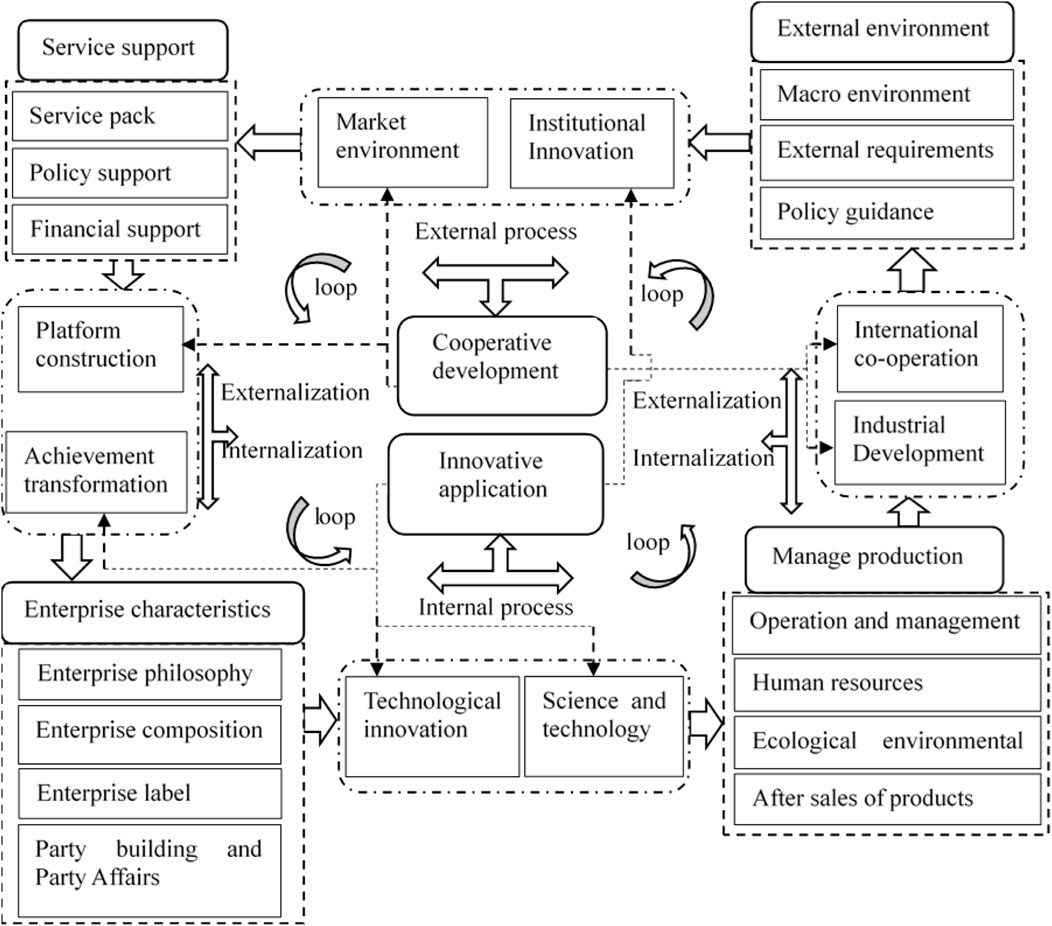
FIGURE 2. Theoretical framework for influencing factors for the high-quality green development of industrial enterprises.
Environmental dimension
The environmental dimension includes two main categories: external environment and service support, which constitute the external environment that affects the high-quality green development of industrial enterprises (Figure 3). The main category of external environment affects the main category of service support. For example, external requirements and policy guidance determine what kind of policy support, financial support, and service support the government will provide. Service support will act on the enterprise dimension and affect enterprise strategy and behavior. In the context of factors influencing high-quality green development of industrial enterprises, this impact is generally positive, that is, the more service support, the more conducive it is for industrial enterprises to carry out high-quality green development-related activities. After the internal reaction of the policy effect in the enterprise dimension, it will eventually be fed back to the main category of the external environment, especially in the sub-category of the macro environment. This feedback can be positive or negative. Positive feedback indicates that the policy itself and its implementation are effective. Negative feedback indicates that there may be loopholes in the policy itself or in the implementation process.
The external environment includes the main category of macro-environments that describes the current economic development environment faced by industrial enterprises and the direction advocated by the state, the main category of external requirements of standards, regulations and regulatory systems formulated by the government to encourage industrial enterprises to achieve high-quality green development, and the main category of policy guidance that describes the mechanism and specific policy measures implemented by the government to encourage industrial enterprises to achieve high-quality green development. The creation of macro environment is very important for industrial development, which has a significant impact on external requirements (Itani and Mason, 2014). This can be verified in the impact of the economic environment on EU policy making (Wallace et al., 2020). At the institutional level, the macroenvironment promotes the improvement of the institutional environment (Caniëls and Baaten, 2019). The main category of external demand and the main category of policy guidance come down in one continuous line, which can be equivalent to the relationship between “head” and “hand” within the government. Therefore, external demand determines the aspect and type of policy that the government will formulate.
Service support includes the main category of service support that describes the public services provided by the government to encourage industrial enterprises to achieve high-quality green development, the main category of policy support that describes the financial, capital, land, business environment and other policy support that the government provides to encourage industrial enterprises to achieve high-quality green development, and the main category of financial support that supports industrial enterprises to achieve high-quality green development in the financial field. The policy support subcategory continues the content of the policy guidance subcategory, which is embodied in specific policy support measures. Related to it is the supporting services. Kjaer et al. (2019) pointed out that the formulation of relevant supporting policies needs to rely on the construction of a service system. Policy support subcategory and financial support subcategory will be misread as inclusive relationship from the literal understanding. However, the provider of financial support is not only the government, but also financial institutions. Given that the Chinese government has an absolute leading role in financial institutions (He and Miao, 2022), policy support determines financial support.
Enterprise dimension
The dimension of the company includes two main categories: the characteristics of the company and the production of the management, which constitute the direct internal factors that affect the high-quality green development of industrial enterprises (Figure 4). The main category of characteristics of the enterprise determines the main category of management and production. There are differences in the management and production behavior of companies with different characteristics (Durst et al., 2019). For example, different concepts of corporate culture will create different ways of operation and management (Eniola et al., 2019); Companies with independent scientific research institutions often provide researchers with a better working environment (Hall et al., 2018). The main category of management production is related to the market through procurement and product, participates in the division of labor in the domestic and foreign industrial chain, and then affects the environmental dimension together with other companies in the industry. The results of the market behavior of all industrial enterprises, whether positive or negative, constitute the external environment. This can also be seen as feedback from the enterprise dimension, forming a closed loop with the policy making mentioned above. The government in the environmental dimension will issue corresponding policies and provide relevant service support measures according to the market feedback results. In essence, it creates a new ecosystem for industrial enterprises. Krizanova et al. (2018) pointed out that the business philosophy and management mode of enterprises are rooted in what kind of ecosystem the enterprise is in, and different ecosystems have created different business modes. When ecology begins to affect enterprises, it will realize a new round of circular action mechanism from the environmental dimension to the main category of characteristics of the company.
Enterprise characteristics include the subcategory of enterprise concepts related to high-quality green development, such as innovation, transformation, ecology, etc., which should be possessed by industrial enterprises, the subcategory of enterprise composition, which describes the establishment of ownership institutions related to high-quality green development, and the subcategory of enterprise labels, which describes the basic situation of industrial enterprises such as scale and nature, and whether enterprises are innovative enterprises, backbone enterprises, high-quality enterprises, technology enterprises, etc. The subcategory of Party building and party affairs, which describes the development of Party building and party affairs activities in industrial enterprises. Enterprise philosophy has different degrees of influence on enterprise composition, enterprise label, and Party building and party affairs. The philosophy of the company determines the subcategory of the composition of the company. Whether industrial enterprises will set up R&D and other institutions related to high-quality green development completely depends on the enterprise’s business philosophy and development culture. The enterprise philosophy affects the subcategory of enterprise labels. Whether an industrial enterprise can become a solid foundation and high-quality enterprise in the industry is greatly affected by enterprise culture. In other words, the philosophy of enterprises is one of the competitive characteristics of enterprises (Ndlela and Du-Toit, 2001; Ikram et al., 2019). Enterprise philosophy affects the subcategory of Party building and party affairs. Whether the party building activities of industrial enterprises are carried out on time and whether the party affairs activities can be completed with high-quality cannot be separated from the attention of enterprises to Party building and party affairs.
Management of production includes the subcategory of operation and management that describes the operation and management capabilities of industrial enterprises, the subcategory of human resources that describes the composition of talents in industrial enterprises, the subcategory of ecological environmental protection that refers to the attention paid by industrial enterprises to the ecological environment before, during and after the production process, and the subcategory of product after-sales that describes whether the products and after-sales of industrial enterprises meet the requirements of high-quality green development. Business management includes human resource management, so it directly determines the composition of human resources; At the same time, good human resources can also provide talent support for business management (Danvila-del-Valle et al., 2019; Ikram et al., 2020). The subcategory of ecological environmental protection can achieve the purpose of regulation through the management and control process, and scholars prefer to call this method green management (Solomon et al., 2019; Maté-Sánchez-Val and Teruel-Gutierrez, 2022). Its most typical application is cleaner production (Ikram et al., 2021). The improvement of the working environment of employees in the ecological environmental protection subcategory can promote the attraction of entrepreneurial talent (González-Masip et al., 2019). In general, under the main category of management and production, the interaction of business management, human resources, and ecological environmental protection ultimately affects the flow of products to the after-sales subcategory. Whether it is management ability, human composition, ecological and environmental protection, the purpose is to create more competitive products and services.
Process dimension
The process dimension includes two main categories: innovative application and cooperative development. It connects the influence feedback mechanism between the environmental dimension and the enterprise dimension, and is the intermediary factor between the environmental dimension and the enterprise dimension and between the enterprise dimension and the environmental dimension (Figure 5). Unlike the environmental dimension or the enterprise dimension, there is no problem in the process dimension that the main category of cooperative development and the main category of innovative application decide the other. The subcategories of the two main categories are mixed in the logical cycle. Therefore, the main concepts contained in each subcategory are shown in the process dimension diagram to clearly analyze the intermediary role of its subcategory.
The intermediary role of the main category of innovative application and cooperative development can be divided into four stages, including the external process from the external environment to service support, the internal process from service support to the external influence of enterprise characteristics, the internal process from enterprise characteristics to management and production, and the external internal feedback process from management and production to the external environment.
In the external process, the policy guidance subcategory will directly promote reform and innovation and pilot projects, and accumulate reform experience; it is embodied in the delimitation of demonstration areas, the adjustment of market regulation mechanism, the adjustment of price mechanism, the ownership reform of industrial enterprises, the innovation of supervision mode, the adjustment of fiscal, tax and financial policies, etc. These behaviors need policy support and related service support. For example, the effectiveness of monetary policy depends on relevant policy tools (Bernanke, 2017).
In the internal process of external influence, the starting point of service support affecting the enterprise dimension is to build innovation and entrepreneurship platforms, improve high-tech demonstration zones and innovation systems, standardize the trading of technological achievements and improve the construction of science and technology business incubators (Ulgiati and Zucaro, 2019; Castillo et al., 2021). At present, China’s connection in this process is not ideal. Kong et al. (2020) pointed out that the construction of innovation platforms is crucial to the implementation of high-quality national development requirements and that the supporting policies for the construction of innovation platforms in China are not perfect, especially on the supply side. For example, the financing mode of science and technology enterprises in region of Beijing Tianjin Hebei is not clear, and the financial support tools are very vague (Wu et al., 2020). Even in Shanghai, which has a high level of economic and technological development, financial support for the transformation of scientific and technological achievements is also faced with problems such as a single dimension of policy tools and insufficient support of scientific and technological intermediaries (Kang et al., 2019; Bal et al., 2021). Including Social Housing Residents in the Energy Transition: A Mixed-Method Case Study on Residents’ Beliefs, Attitudes, and Motivation Toward Sustainable Energy Use in a Zero-Energy Building Renovation in the Netherlands. Frontiers in Sustainable Cities, 3, 656781.).
In the internal process, from the main category of characteristics of the company to the main category of management and production, it can be simplified as the problem from the concept of industrial enterprise culture to the production of the product. Under the concept of high-quality green development, more high-quality green elements will be invested to obtain better quality and more eco-friendly products at the terminal (Pahlevi and Suhartanto, 2020). According to the view of endogenous growth theory, the main driving force of this process is scientific and technological progress (Aghion et al., 1998). Therefore, the main concepts of green technology, information technology, core technology, scientific and technological resources, and innovative achievements contained in the two subcategories of science and technology and technological innovation link the two ends of cultural ideas and product production and act on all links of its internal process.
In the process of internal and external feedback, international cooperation and industrial development are involved (Gould and Lewis, 2021; Breen et al., 2020). Enterprises are not isolated but part of the industrial chain. Even industrial enterprises with the whole industrial chain also have business parts to cooperate with other enterprises. At the purchase end and at the product end, companies will participate in market competition. Many industrial enterprises in the same industry together form the domestic and foreign markets with the attributes of cooperation and competition, and then form the macro-environment for the development of industrial enterprises. The subcategory of international cooperation and industrial development acts as an intermediary between the macroenvironment and the dimensions of the company and is based on market cooperation and competition. For example, the international energy market cooperation relationship has stable national energy security (Umbach, 2010). There is a positive relationship between the intensity of competition of pharmaceutical companies and their scientific and technological innovation. More pharmaceutical enterprise innovation will improve the welfare of patients and society (Cantwell and Kosmopoulou, 2003).
Conclusion and managerial implications
Conclusion
This paper collects and obtains original text materials such as policy documents, policy interpretation, and official public opinion related to the high-quality green development of Chinese industrial enterprises, uses grounded theory to carry out three-level coding, and constructs the theoretical framework model of the factors influencing of the high-quality green development of industrial enterprises. The model is divided into three dimensions: environment, enterprise, and process, and six main categories. The environmental dimension is the external driving factor, including the main category of external environment and service support, which play an indirect role in the high-quality green development of industrial enterprises; The enterprise dimension is the internal driving factor, including the enterprise characteristics and the main category of management and production that play a direct role in the high-quality green development of industrial enterprises; The process dimension is a circular driving factor, including the main category of innovative application and cooperative development that plays a circular role in the high-quality green development of industrial enterprises.
After coding analysis, we find that many factors can determine or affect the high-quality green development of industrial enterprises. These factors have two characteristics. On the one hand, multiple factors can be clustered into a group or a class of factors. Among the 137 main concepts of open coding, many concepts express the same kind of transactions. Then such concepts can be clustered into a group, called “category”. If multiple categories describe the same object, they will be divided into the same main category. By analogy, three “dimensions” are finally formed. On the other hand, there is a logical relationship between each group of factors. Each factor or group of factors has an impact on the high-quality green development of industrial enterprises. But there are also logical relationships between categories or dimensions. For example, the process dimension concatenates the environment dimension and the enterprise dimension. There is no direct impact relationship between the environment dimension and enterprise dimension in this process. It is transmitted from the environmental dimension to the process dimension, and then from the process dimension to the enterprise dimension, and vice versa. Another example found in the study can prove the logical relationship within the main category. Under the dimension level, there are positive promoting relationships, determining relationships, and influencing relationships that cannot determine the direction among the categories within each main category. The internal influence of the main category is more complicated than the dimension level. This influence relationship may be one-way or two-way; It may also be one to many, one to one, or many to one.
This paper closely follows the policy trend and constructs the model of influencing factors high-quality green development of industrial enterprises under the background of green development and the requirements of high-quality development, which has important theoretical significance. First, it has expanded research in the field of high-quality green development. High-quality green development is a relatively new concept and the relevant academic research is not rich. It is easy to cause the lack and omission of inductive factors by rashly copying with existing theories and experience; The use of grounded theory can meet this scenario, focus on industrial enterprises, and expand and enrich high-quality green development research from the theoretical level. The second is to systematically summarize the reasons that affect the level of high-quality green development of industrial enterprises. The research method of collecting written materials by the latest deadline and adopting three-level coding ensures the good timeliness of the data and the systematicness of material analysis, forming a "3 + 6+22″ coding system. The third is to clarify the logical relationship and the correlation mechanism between the influencing factors. Influencing factors are not completely isolated. From the analysis of the typical relationship structure of the main category in the grounded theory to the formation of the theoretical framework of the influencing factors, and then to the stepwise analysis of sub dimensions, the logical relationship and correlation mechanism among the dimensions, main categories, and indicators are clarified.
Managerial implications
According to the division of dimension levels after the three-level coding, the subjects related to the high-quality green development of industrial enterprises mainly include the government, industrial enterprises, and platform organizations.
The government’s decision and behavior will directly affect the factors related to the environmental dimension. Therefore, to promote the high-quality green development of industrial enterprises, the government needs to create an external environment and provide corresponding service support according to the demands of enterprises. For example, the government should formulate high-quality green development standards, regulations, and regulatory systems; Encourage high-quality green development activities according to laws and regulations, and punish violations of relevant standards and regulations. In addition, the government also needs to provide public support facilities. Competent local governments can provide special land, simplify the approval process of high-quality green development projects, and provide tax reduction or subsidy policies. The government also needs to take the lead in facilitating the negotiation and cooperation between industrial enterprises and financial institutions and provide green financial services to guide industrial enterprises to implement high-quality green development.
Industrial enterprises are the most important and direct subjects to implementing high-quality green development. To better achieve high-quality green development, industrial enterprises should shape high-quality and green enterprise culture. Cultivate the sense of innovation and green development. Strengthen party building and adhere to the party’s theory to guide practice. Qualified enterprises also need to set up independent scientific research centers. Strive to become a benchmark enterprise in the industry. In the management and production links, we should pay attention to the construction and training of the talent team and constantly optimize the human resource structure. Implement clean production and realize green packaging of products.
Platform organizations including industry associations and platform enterprises can play a vital role between the government and industrial enterprises. They are a bridge between the government and industrial enterprises. Therefore, the platform organization should participate in the platform construction and create several technology trading platforms, technology incubation platforms, and financial platforms. Represent the interests of the industry to express their demands to the government and make up for the lack of voice of small and micro enterprises. Promote cooperation between Chinese and foreign enterprises. Encourage healthy competition among enterprises.
Limitations and future directions
Restricted by the richness of the data, there are still some research deficiencies. In practical understanding, it is found that the structure of industrial enterprises in different regions is not the same. For example, the proportion of industrial enterprises with high pollution and high energy consumption in the developed eastern region is small, while such enterprises in the western region account for more. Text materials at the national level cannot reflect the differences in the impact of high-quality green development caused by different proportion structures of enterprises. In addition, industry differences can also cause changes in influencing factors. Industrial enterprises with high pollution and high energy consumption are mainly concentrated in upstream industries, such as mining and power generation industries; The high-quality green development of downstream industries is relatively good. Therefore, different regions and industries should be treated differently. Follow-up research will subdivide regions and industries to form a more comprehensive and perfect influencing factor model of high-quality green development of industrial enterprises.
Data availability statement
The original contributions presented in the study are included in the article/Supplementary material, further inquiries can be directed to the corresponding authors.
Author contributions
ZF: Conceptualization, Writing—original draft, and methodology. CY: supervision and formal analysis. XS: variable construction. Funding acquisition. Data handling. All authors have read and agreed to the published version of the manuscript.
Conflict of interest
Author CY was employed by the company Sinotruk Finance Co., Ltd.
The remaining authors declare that the research was conducted in the absence of any commercial or financial relationships that could be construed as a potential conflict of interest.
Publisher’s note
All claims expressed in this article are solely those of the authors and do not necessarily represent those of their affiliated organizations, or those of the publisher, the editors and the reviewers. Any product that may be evaluated in this article, or claim that may be made by its manufacturer, is not guaranteed or endorsed by the publisher.
References
Aghion, P., Ljungqvist, L., Howitt, P., Howitt, P. W., Brant-Collett, M., and García-Peñalosa, C. (1998). Endogenous growth theory. Cambridge: MIT press.
Akomea-Frimpong, I., Kukah, A. S., Jin, X., Osei-Kyei, R., and Pariafsai, F. (2022). Green finance for green buildings: A systematic review and conceptual foundation. J. Clean. Prod. 356, 131869. doi:10.1016/j.jclepro.2022.131869
Bal, M., Stok, F. M., Van Hemel, C., and De Wit, J. B. (2021). Including social housing residents in the energy transition: A mixed-method case study on residents' Beliefs, Attitudes, and motivation toward sustainable energy use in a zero-energy building renovation in the Netherlands. Front. Sustain. Cities 3, 656781. doi:10.3389/frsc.2021.656781
Begum, S., Ashfaq, M., Xia, E., and Awan, U. (2022). Does green transformational leadership lead to green innovation? The role of green thinking and creative process engagement. Bus. Strategy Environ. 31 (1), 580–597. doi:10.1002/bse.2911
Bernanke, B. S. (2017). “Monetary policy in a new era,” in Evolution or revolution?: Rethinking macroeconomic policy after the great recession (Cambridge: MIT press), 3–48.
Breen, A., Giannotti, E., Flores Molina, M., and Vásquez, A. (2020). From “government to governance”? A systematic literature review of research for urban green infrastructure management in Latin America. Front. Sustain. Cities 2, 572360. doi:10.3389/frsc.2020.572360
Burke, P. J., and Do, T. N. (2021). Greening Asia's economic development. Asian Econ. Policy Rev. 16 (1), 22–39. doi:10.1111/aepr.12316
Caniëls, M. C., and Baaten, S. M. (2019). How a learning-oriented organizational climate is linked to different proactive behaviors: The role of employee resilience. Soc. Indic. Res. 143 (2), 561–577. doi:10.1007/s11205-018-1996-y
Cantwell, J., and Kosmopoulou, E. (2003). “Technological innovation,” in Multinational enterprises, innovative strategies and systems of innovation (Cheltenham: Edward elgar publishing), 47.
Cardinale, R. (2021). State-owned enterprises’ reforms and their implications for the resilience and vulnerability of the Chinese economy: evidence from the banking, energy and telecom sectors. Netw. Spat. Econ. 21 (2), 1–26. doi:10.1007/s11067-021-09540-x
Castillo, M. D., Anenberg, S. C., Chafe, Z. A., Huxley, R., Johnson, L. S., Kheirbek, I., et al. (2021). Quantifying the health benefits of urban climate mitigation actions: Current state of the epidemiological evidence and application in health impact assessments. Front. Sustain. Cities 3, 768227. doi:10.3389/frsc.2021.768227
Charmaz, K. (2006). Constructing grounded theory: A practical guide through qualitative analysis. California: Sage publications.
Chen, S. Y., and Chen, D. K. (2018). Air pollution, government regulations and high-quality economic development. Econ. Res. J. 53 (02), 20–34.
Corbin, J. M., and Strauss, A. (2014). Basics of qualitative research: Techniques and procedures for developing grounded theory. California: Sage publications.
Corbin, J. M., and Strauss, A. (1990). Grounded theory research: Procedures, canons, and evaluative criteria. Qual. Sociol. 13 (1), 3–21. doi:10.1007/bf00988593
Danisman, G. O., Demir, E., and Ozili, P. (2021). Loan loss provisioning of US banks: Economic policy uncertainty and discretionary behavior. Int. Rev. Econ. Finance 71, 923–935. doi:10.1016/j.iref.2020.10.016
Danvila-del-Valle, I., Estévez-Mendoza, C., and Lara, F. J. (2019). Human resources training: A bibliometric analysis. J. Bus. Res. 101, 627–636. doi:10.1016/j.jbusres.2019.02.026
Deganello, F., and Bos, J. W. G. (2022). Innovations in energy engineering and cleaner production: A sustainable chemistry perspective. Sustain. Chem. 3 (1), 112–113. doi:10.3390/suschem3010008
Deng, F., Li, H., Yang, M., Zhao, W., Gai, Z., Guo, Y., et al. (2021). On the nonlinear relationship between energy consumption and economic and social development: evidence from henan province, China. Environ. Sci. Pollut. Res. 28 (25), 33192–33207. doi:10.1007/s11356-021-12623-4
Dhar, B. K., Sarkar, S. M., and Ayittey, F. K. (2022). Impact of social responsibility disclosure between implementation of green accounting and sustainable development: A study on heavily polluting companies in Bangladesh. Corp. Soc. Responsib. Environ. Manag. 29 (1), 71–78. doi:10.1002/csr.2174
Draucker, C. B., Martsolf, D. S., Ross, R., and Rusk, T. B. (2007). Theoretical sampling and category development in grounded theory. Qual. Health Res. 17 (8), 1137–1148. doi:10.1177/1049732307308450
Durst, S., Hinteregger, C., and Zieba, M. (2019). The linkage between knowledge risk management and organizational performance. J. Bus. Res. 105, 1–10. doi:10.1016/j.jbusres.2019.08.002
Eniola, A. A., Olorunleke, G. K., Akintimehin, O. O., Ojeka, J. D., and Oyetunji, B. (2019). The impact of organizational culture on total quality management in SMEs in Nigeria. Heliyon 5 (8), e02293. doi:10.1016/j.heliyon.2019.e02293
Glaser, B. G., and Strauss, A. L. (2017). The discovery of grounded theory: Strategies for qualitative research. England: Routledge.
González-Masip, J., Martín-de Castro, G., and Hernández, A. (2019). Inter-organisational knowledge spillovers: attracting talent in science and technology parks and corporate social responsibility practices. J. Knowl. Manag. 23 (5), 975–997. doi:10.1108/jkm-06-2018-0367
Gould, K. A., and Lewis, T. L. (2021). Resilience gentrification: environmental privilege in an age of coastal climate disasters. Front. Sustain. Cities 3, 687670. doi:10.3389/frsc.2021.687670
Hall, K. L., Vogel, A. L., Huang, G. C., Serrano, K. J., Rice, E. L., Tsakraklides, S. P., et al. (2018). The science of team science: A review of the empirical evidence and research gaps on collaboration in science. Am. Psychol. 73 (4), 532–548. doi:10.1037/amp0000319
Hao, Y., Li, Y., Guo, Y., Chai, J., Yang, C., and Wu, H. (2022). Digitalization and electricity consumption: Does internet development contribute to the reduction in electricity intensity in China? Energy Policy 164, 112912. doi:10.1016/j.enpol.2022.112912
Hao, Y., Ye, B., Gao, M., Wang, Z., Chen, W., Xiao, Z., et al. (2020). How does ecology of finance affect financial constraints? Empirical evidence from Chinese listed energy-and pollution-intensive companies. J. Clean. Prod. 246, 119061. doi:10.1016/j.jclepro.2019.119061
He, D. X., and Miao, W. L. (2022). Fiscal decentralization, financial decentralization and macroeconomic governance. China Econ. 17 (1), 84–105. doi:10.19602/j.chinaeconomist.2022.0L07
Hong, M., Drakeford, B., and Zhang, K. (2020). The impact of mandatory CSR disclosure on green innovation: evidence from China. Green Finance 2 (3), 302–322. doi:10.3934/gf.2020017
Hou, J., Teo, T. S., Zhou, F., Lim, M. K., and Chen, H. (2018). Does industrial green transformation successfully facilitate a decrease in carbon intensity in China? An environmental regulation perspective. J. Clean. Prod. 184, 1060–1071. doi:10.1016/j.jclepro.2018.02.311
Ikram, M., Ferasso, M., Sroufe, R., and Zhang, Q. (2021). Assessing green technology indicators for cleaner production and sustainable investments in a developing country context. J. Clean. Prod. 322, 129090. doi:10.1016/j.jclepro.2021.129090
Ikram, M., Zhang, Q., Sroufe, R., and Ferasso, M. (2020). The social dimensions of corporate sustainability: an integrative framework including COVID-19 insights. Sustainability 12 (20), 8747. doi:10.3390/su12208747
Ikram, M., Zhou, P., Shah, S. A. A., and Liu, G. Q. (2019). Do environmental management systems help improve corporate sustainable development? Evidence from manufacturing companies in Pakistan. J. Clean. Prod. 226, 628–641. doi:10.1016/j.jclepro.2019.03.265
Itani, N., and Mason, K. (2014). A macro-environment approach to civil aviation strategic planning. Transp. Policy 33, 125–135. doi:10.1016/j.tranpol.2014.02.024
Jia, S., Qiu, Y., and Yang, C. (2021). Sustainable development goals, financial inclusion, and grain security efficiency. Agronomy 11 (12), 2542. doi:10.3390/agronomy11122542
Jia, S., Yang, C., Wang, M., and Failler, P. (2022). Heterogeneous impact of land-use on climate change: Study from a spatial perspective. Front. Environ. Sci. 510. doi:10.3389/fenvs.2022.840603
Jiahuey, Y., Liu, Y., and Yu, Y. (2019). Measuring green growth performance of China's chemical industry. Resour. Conservation Recycl. 149, 160–167. doi:10.1016/j.resconrec.2019.03.025
Jin, B. (2018). Economic research on “high quality development”. China Ind. Econ. 4, 5–18. doi:10.19581/j.cnki.ciejournal.2018.04.001
Kang, W., Zhao, S., Song, W., and Zhuang, T. (2019). Triple helix in the science and technology innovation centers of China from the perspective of mutual information: A comparative study between beijing and Shanghai. Scientometrics 118 (3), 921–940. doi:10.1007/s11192-019-03017-y
Khan, N. A., and Khan, A. N. (2019). What followers are saying about transformational leaders fostering employee innovation via organisational learning, knowledge sharing and social media use in public organisations? Gov. Inf. Q. 36 (4), 101391. doi:10.1016/j.giq.2019.07.003
Khan, S. A. R., Yu, Z., and Umar, M. (2022). A road map for environmental sustainability and green economic development: An empirical study. Environ. Sci. Pollut. Res. 29 (11), 16082–16090. doi:10.1007/s11356-021-16961-1
Kjaer, L. L., Pigosso, D. C., Niero, M., Bech, N. M., and McAloone, T. C. (2019). Product/service‐systems for a circular economy: the route to decoupling economic growth from resource consumption? J. Industrial Ecol. 23 (1), 22–35. doi:10.1111/jiec.12747
Kong, Y., Feng, C., and Yang, J. (2020). How does China manage its energy market? A perspective of policy evolution. Energy Policy 147, 111898. doi:10.1016/j.enpol.2020.111898
Koutsoyiannis, D. (2011). Scale of water resources development and sustainability: Small is beautiful, large is great. Hydrological Sci. J. 56 (4), 553–575. doi:10.1080/02626667.2011.579076
Krizanova, A., Gajanova, L., and Nadanyiova, M. (2018). Design of a CRM level and performance measurement model. Sustainability 10 (7), 2567. doi:10.3390/su10072567
Liu, Y., Liu, M., Wang, G., Zhao, L., and An, P. (2021). Effect of environmental regulation on high-quality economic development in China—an empirical analysis based on dynamic spatial durbin model. Environ. Sci. Pollut. Res. 28 (39), 54661–54678. doi:10.1007/s11356-021-13780-2
Lukas, E. N. (2015). Green economy for sustainable development and poverty eradication. Mediterr. J. Soc. Sci. 6 (6 S5), 434. doi:10.5901/mjss.2015.v6n6s5p434
Ma, D., and Zhu, Q. (2022). Innovation in emerging economies: Research on the digital economy driving high-quality green development. J. Bus. Res. 145, 801–813. doi:10.1016/j.jbusres.2022.03.041
Madsen, D. N., and Hansen, J. P. (2019). Outlook of solar energy in Europe based on economic growth characteristics. Renew. Sustain. Energy Rev. 114, 109306. doi:10.1016/j.rser.2019.109306
Maté-Sánchez-Val, M., and Teruel-Gutierrez, R. (2022). Evaluating the effects of hotel location on the adoption of green management strategies and hotel performance. J. Sustain. Tour. 30 (8), 2029–2052. doi:10.1080/09669582.2021.1995397
Ndlela, L. T., and Du-Toit, A. S. A. (2001). Establishing a knowledge management programme for competitive advantage in an enterprise. Int. J. Inf. Manag. 21 (2), 151–165. doi:10.1016/s0268-4012(01)00007-x
Pahlevi, M. R., and Suhartanto, D. (2020). The integrated model of green loyalty: Evidence from eco-friendly plastic products. J. Clean. Prod. 257, 120844. doi:10.1016/j.jclepro.2020.120844
Pearce, D. W., and Atkinson, G. D. (1993). Capital theory and the measurement of sustainable development: an indicator of “weak” sustainability. Ecol. Econ. 8 (2), 103–108. doi:10.1016/0921-8009(93)90039-9
Rana, S., Prashar, S., Barai, M. K., and Hamid, A. B. A. (2020). Determinants of international marketing strategy for emerging market multinationals. Int. J. Emerg. Mark. 16 (2), 154–178. doi:10.1108/ijoem-09-2019-0742
Raparthi, K. (2015). Assessing smart-growth strategies in Indian cities: Grounded theory approach to planning practice. J. Urban Plan. Dev. 141 (4), 05014031. doi:10.1061/(asce)up.1943-5444.0000267
Ren, B. P., and Wen, F. A. (2018). The criteria, determinants and ways to achieve high-quality development in China in the new era. Reform 4, 5–16. doi:10.19629/j.cnki.34-1014/f.210516004
Ren, S., Hao, Y., and Wu, H. (2022). Digitalization and environment governance: does internet development reduce environmental pollution? J. Environ. Plan. Manag.98, 105220. doi:10.1080/09640568.2022.2033959
Ren, S., Hao, Y., Xu, L., Wu, H., and Ba, N. (2021). Digitalization and energy: How does internet development affect China's energy consumption? Energy Econ. 98, 105220. doi:10.1016/j.eneco.2021.105220
Seager, T. P. (2008). The sustainability spectrum and the sciences of sustainability. Bus. Strategy Environ. 17 (7), 444–453. doi:10.1002/bse.632
Sembiring, J., Nuryatno, D. E., and Gondokaryono, Y. S. (2011). “Analyzing the indicators and requirements in main components of Enterprise Architecture methodology development Using Grounded Theory in qualitative methods,” in Society of Interdisciplinary Business Research (SIBR) 2011 Conference on Interdisciplinary Business Research, Bangkok, June 16-18.
Shapira, P., Gök, A., Klochikhin, E., and Sensier, M. (2014). Probing “green” industry enterprises in the UK: A new identification approach. Technol. Forecast. Soc. change 85, 93–104. doi:10.1016/j.techfore.2013.10.023
Shen, Z., Wu, H., Bai, K., and Hao, Y. (2022). Integrating economic, environmental and societal performance within the productivity measurement. Technol. Forecast. Soc. Change 176, 121463. doi:10.1016/j.techfore.2021.121463
Shi, L., Han, L., Yang, F., and Gao, L. (2019). The evolution of sustainable development theory: Types, goals, and research prospects. Sustainability 11 (24), 7158. doi:10.3390/su11247158
Sikander, M., Kumar, L., Naqvi, S. A., Arshad, M., and Jabeen, S. (2021). Sustainable practices for reduction of environmental footprint in tanneries of Pakistan. Case Stud. Chem. Environ. Eng. 4, 100161. doi:10.1016/j.cscee.2021.100161
Solomon, S., Quirk, R. G., and Shukla, S. K. (2019). Special issue: Green management for sustainable sugar industry. Sugar Tech. 21 (2), 183–185. doi:10.1007/s12355-019-00711-2
Song, M., Tao, W., and Shen, Z. (2022). Improving high-quality development with environmental regulation and industrial structure in China. J. Clean. Prod. 366, 132997. doi:10.1016/j.jclepro.2022.132997
Strauss, A., and Corbin, J. M. (1988). Basics of qualitative research: Grounded theory procedures and technique. California: Sage publications.
Ulgiati, S., and Zucaro, A. (2019). Challenges in urban metabolism: sustainability and well-being in cities. Front. Sustain. Cities 1, 1. doi:10.3389/frsc.2019.00001
Umbach, F. (2010). Global energy security and the implications for the EU. Energy policy 38 (3), 1229–1240. doi:10.1016/j.enpol.2009.01.010
Wallace H., Pollack M. A., Roederer-Rynning C., and Young A. R. (Editors) (2020). Policy-making in the European union (USA: Oxford University Press).
Wang, M., Gu, R., Wang, M., Zhang, J., Press, B. C. S., and Branch, B. O. C. S. (2021). Research on the impact of finance on promoting technological innovation based on the state-space model. Green Finance 3 (2), 119–137. doi:10.3934/gf.2021007
Wang, M., Zhao, X., Gong, Q., and Ji, Z. (2019). Measurement of regional green economy sustainable development ability based on entropy weight-topsis-coupling coordination degree—a case study in shandong province, China. Sustainability 11 (1), 280. doi:10.3390/su11010280
Wu, H., Ba, N., Ren, S., Xu, L., Chai, J., Irfan, M., et al. (2022). The impact of internet development on the health of Chinese residents: Transmission mechanisms and empirical tests. Socio-Economic Plan. Sci. 81, 101178. doi:10.1016/j.seps.2021.101178
Wu, H., Hao, Y., and Ren, S. (2020). How do environmental regulation and environmental decentralization affect green total factor energy efficiency: Evidence from China. Energy Econ. 91, 104880. doi:10.1016/j.eneco.2020.104880
Xu, M., Albitar, K., and Li, Z. (2020). Does corporate financialization affect EVA? Early evidence from China. Green Finance 2 (4), 392–408. doi:10.3934/gf.2020021
Xue, Y., Jiang, C., Guo, Y., Liu, J., Wu, H., and Hao, Y. (2022). Corporate social responsibility and high-quality development: Do green innovation, environmental investment and corporate governance matter? Emerg. Mark. Finance Trade 58, 3191–3214. doi:10.1080/1540496x.2022.2034616
Yang, R. D. (2015). Study on the total factor productivity of Chinese manufacturing enterprises. Econ. Res. J. 2, 61–74.
Yang, Y., Su, X., and Yao, S. (2021). Nexus between green finance, fintech, and high-quality economic development: Empirical evidence from China. Resour. Policy 74, 102445. doi:10.1016/j.resourpol.2021.102445
Yao, Y., Hu, D., Yang, C., and Tan, Y. (2021). The impact and mechanism of fintech on green total factor productivity. Green Finance 3, 198–221. doi:10.3934/gf.2021011
Yuan, Q., Yang, D., Yang, F., Luken, R., Saieed, A., and Wang, K. (2020). Green industry development in China: An index based assessment from perspectives of both current performance and historical effort. J. Clean. Prod. 250, 119457. doi:10.1016/j.jclepro.2019.119457
Zhang, W., Li, G. X., Uddin, M. K., and Shucen Guo, S. C. (2020). Environmental regulation, Foreign investment behavior, and carbon emissions for 30 provinces in China. J. Clean. Prod. 248, 119208. doi:10.1016/j.jclepro.2019.119208
Zheng, Y., Chen, S., and Wang, N. (2020). Does financial agglomeration enhance regional green economy development? Evidence from China. Green Finance 2 (2), 173–196. doi:10.3934/gf.2020010
Keywords: industrial enterprises, high-quality green development, grounded theory, influencing factor model, green development
Citation: Fang Z, Yang C and Song X (2022) Construction of influencing factor model for high-quality green development of Chinese industrial enterprises. Front. Environ. Sci. 10:1006224. doi: 10.3389/fenvs.2022.1006224
Received: 29 July 2022; Accepted: 05 September 2022;
Published: 28 October 2022.
Edited by:
Muhammad Ikram, Al Akhawayn University, MoroccoReviewed by:
Luigi Aldieri, University of Salerno, ItalyLove Kumar, University of Florida, United States
Copyright © 2022 Fang, Yang and Song. This is an open-access article distributed under the terms of the Creative Commons Attribution License (CC BY). The use, distribution or reproduction in other forums is permitted, provided the original author(s) and the copyright owner(s) are credited and that the original publication in this journal is cited, in accordance with accepted academic practice. No use, distribution or reproduction is permitted which does not comply with these terms.
*Correspondence: Can Yang, ZmFuZ3poZW56aGVuZ2NlQDE2My5jb20=; Xiaowei Song, eGlhb21pcWlAMTI2LmNvbQ==
 Zhen Fang1
Zhen Fang1 Can Yang
Can Yang Xiaowei Song
Xiaowei Song